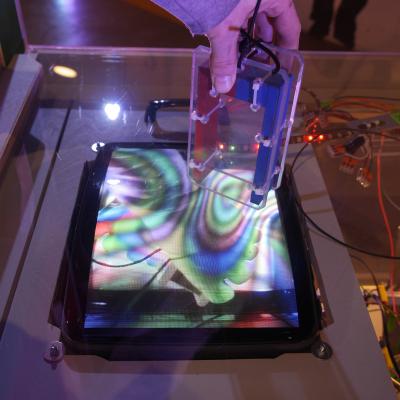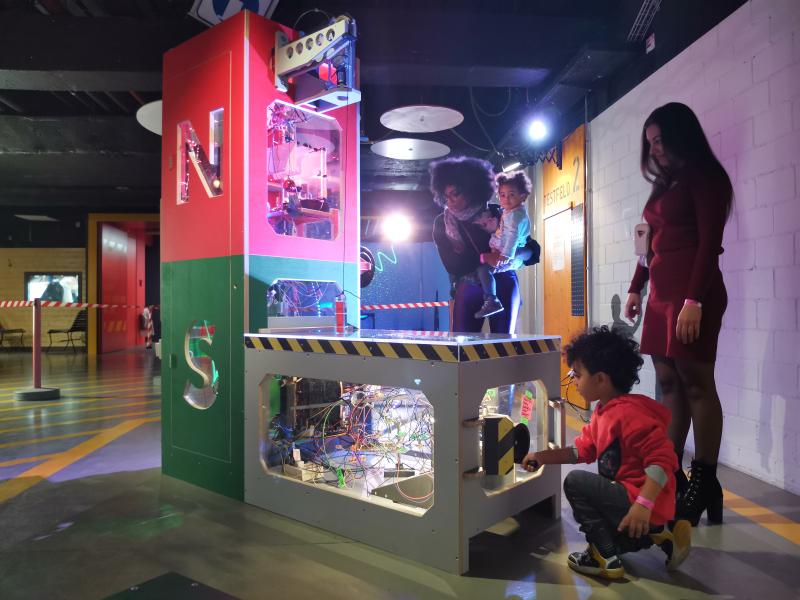Magnets, how do they work? Although the quantum mechanics behind ferromagnetism are by no means easy, a few simple experiments can give you a good grasp of how magnets attract and repel each other, and show how they interact with electric phenomena. [Niklas Roy] built an exhibit for the Technorama science museum in Switzerland that packs a bunch of such electromagnetic experiments in a single package, appropriately called the Visitors Magnet.
The exhibit consists of a big magnet-shaped enclosure that contains a variety of demonstrators that are all powered by magnets. They range from simple compasses to clever magnetic devices we find in the world around us: flip-dot displays for instance, on which you can toggle the pixels by passing a magnet over them. You can even visualize magnetic field lines by using magnetic viewing film, or turn varying fields into audio through a modified telephone receiver.
 Another classic demonstrator of electromagnetism is a color CRT monitor, which here displays a video feed coming from a camera hanging directly overhead. Passing a magnet along the screen makes all kind of hypnotizing patterns and colors, amplified even more by the video feedback loop. [Niklas] also modified the picture tube with an additional coil, connected to a hand-cranked generator: this allows visitors to rotate the image on the screen by generating an AC current, neatly demonstrating the interaction between electricity and magnetism.
Another classic demonstrator of electromagnetism is a color CRT monitor, which here displays a video feed coming from a camera hanging directly overhead. Passing a magnet along the screen makes all kind of hypnotizing patterns and colors, amplified even more by the video feedback loop. [Niklas] also modified the picture tube with an additional coil, connected to a hand-cranked generator: this allows visitors to rotate the image on the screen by generating an AC current, neatly demonstrating the interaction between electricity and magnetism.
The Visitors Magnet is a treasure trove of big and small experiments, which might not all withstand years of use by museum guests. But that’s fine — [Niklas] designed the exhibit to be easy to maintain and repair, and expects the museum to replace worn-out experiments now and then to keep the experience fresh. He knows a thing or two about designing engaging museum exhibits, with a portfolio that includes vector image generators, graffiti robots and a huge mechanical contraption that plays musical instruments.
















Back when I TAed a physiology lab course for pre-meds, the first lab was how to calibrate the oscilloscope used in the next few labs. Occasionally, I know not how, a magnet would adhere to the metal case near the path of the CTR’s electron beam. I liked to think of it as helping the students think outside the box.
What’s a CTR?
It’s a misspelling of CRT, or cathode ray tube.
>demonstrating the interaction between electricity and magnetism
How much does it demonstrate to a person who doesn’t already know how a CRT works, and isn’t familiar with the concept because CRTs are no longer used?
Methinks demonstrations like this are nothing more than “look, cool magic happens when you wiggle this” – leaving the audience no wiser to anything. Something more concrete is needed, like actually being able to see the electron beam inside a vacuum tube and watch it bend. A good old-fashioned Crookes tube for example.
Indeed, this installation does not explain how CRT’s work and that’s also not the intention. It’s a showcase of different objects and materials which all deal with magnetism and it will be part of an exhibition with plenty of other exhibits. Each of those other exhibits will focus on one aspect of magnetism and/or electricity and demonstrate that aspect in a very clear and understandable hands-on way. I guess you’ll find the rest of the exhibition more interesting than the visitors magnet. Others might be attracted to the visitors magnet, because it offers a lot to explore and it might just look appealing to them.
One of the other exhibits in that section of the museum will be the one @one mentioned above. That’s at least quite close to a Crookes magnetic deflection tube.